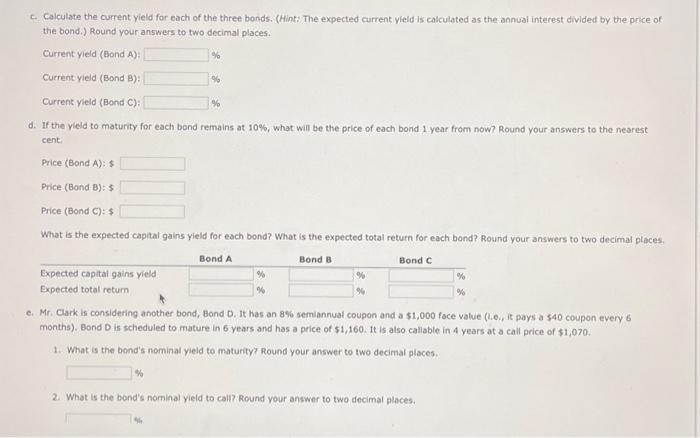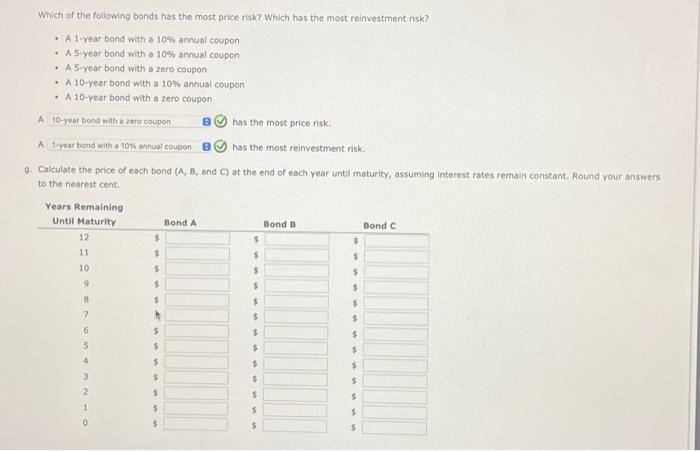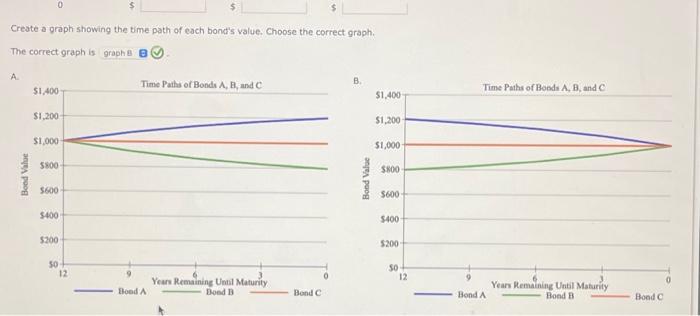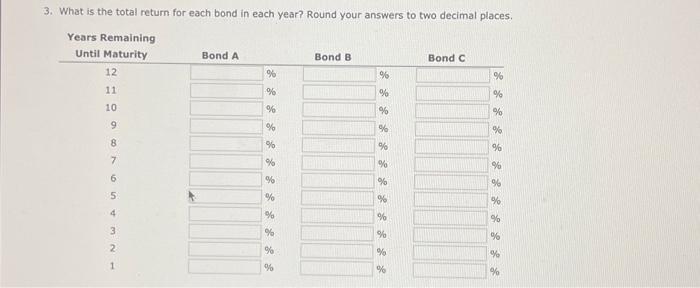hello, this is 1 question it is just super long. This problem is on bond valuation and below i provided the information needed. thank you for your help!!
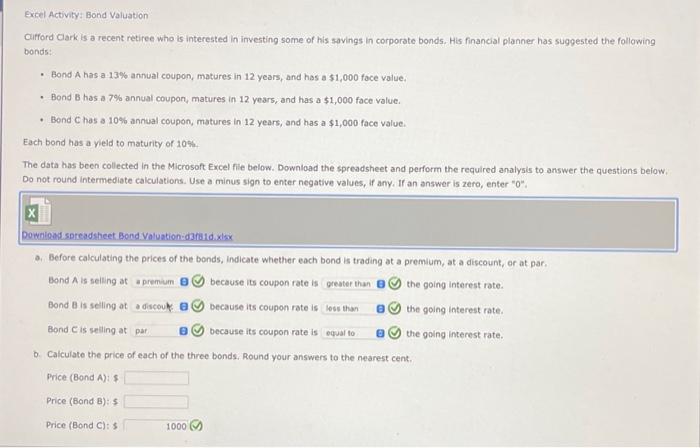
Excel Activity: Bond Valuation Cifford Cark is a recent retiree who is interested in investing some of his savings in corporate bonds. His financial planner has suggested the following bonds: - Bond A has a -13\% annual coupon, matures in 12 years, and has a $1,000 foce value. - Bond 8 has a 7% annual coupon, matures in 12 years, and has a $1,000 face value. - Bend C has a 10% annual coupon, matures in 12 years; and has a $1,000 face value. Each bond has a yeld to maturity of 10%. The data has been collected in the Microsoft Excel file below. Download the spreadsheet and perform the required analysis to answer the questions beiow, Do not round intermediate calculations. Use a minus sign to enter negative values, if any, If an answer is zero, enter " 0 ". Downiogispreadsheet Bend.Valuation-d3fididisis a. Before calculating the prices of the bonds, indicate whether each bond is trading at a premium, at a discount, or at par, Bond A is seling at because its coupon rate is the going interest rate. Bond B is selling at because its coupon rate is the going interest rate. Bond C is selling at because its coupon rate is the going interest rate. b. Calculate the price of each of the three bonds, Round your answers to the nearest cent, Price ( Bond A):$ Price (Bond B): 5 Price ( Bond C):s c. Calculate the current yield for each of the three bonds. (Hint: The expected current yield is calculated as the annual interest divided by the price of the bond.) Round your answers to two decimal places. Current yield (Bond A): % Current yield (Band B): Current yield (Bond C): d. If the yleld to maturity for each bond remains at 10%, what will be the price of each bond 1 year from now? Round your answers to the nearest cent, Price (Bend A):$ Price (Bond B):5 Price ( Bond C)5 What is the expected capital gains yield for each bond? What is the expected total return for each bond? Round your answers to two decimal places. e. Mr, Cark is considering another bond, Bond D. It has an 8% semiannual coupon and a $1,000 face value (l.e., it pays a 540 coupon every 6 months). Bond D is scheduled to mature in 6 years and has a price of $1,160. 1t is also callable in 4 years at a call price of $1,070. 1. What is the bond's nominal yield to maturity? Round your answer to two decimal ploces. 2. What is the bond's nominal yield to call? Round your answer to two decimal places. Which of the following bonds has the most price risk? Which has the most reinvestment risk? - A 1-year bond with a 10% annual coupon - A 5-year bond with a 10% anmual coupon - A.5-year bond with a zero coupon - A 10-year bond with a 10*y annual coupon - A 10-year bond with a zero coupon A has the most price risk. A has the most reinvestment risk. 9. Calculate the price of each bond (A,B, snd C) at the end of each year until maturity, assuming interest rates remain constant. Round your answers to the nearest cent. Create a graph showing the time path of each bond's value. Choose the correct graph. The correct graph is 1. What is the expected current yield for each bond in each year? Round your answers to two decimal places. 2. What is the expected capital gains yield for each bond in each year? Round your answers to two decimal places. 3. What is the total return for each bond in each year? Round your answers to two decimal places. Excel Activity: Bond Valuation Cifford Cark is a recent retiree who is interested in investing some of his savings in corporate bonds. His financial planner has suggested the following bonds: - Bond A has a -13\% annual coupon, matures in 12 years, and has a $1,000 foce value. - Bond 8 has a 7% annual coupon, matures in 12 years, and has a $1,000 face value. - Bend C has a 10% annual coupon, matures in 12 years; and has a $1,000 face value. Each bond has a yeld to maturity of 10%. The data has been collected in the Microsoft Excel file below. Download the spreadsheet and perform the required analysis to answer the questions beiow, Do not round intermediate calculations. Use a minus sign to enter negative values, if any, If an answer is zero, enter " 0 ". Downiogispreadsheet Bend.Valuation-d3fididisis a. Before calculating the prices of the bonds, indicate whether each bond is trading at a premium, at a discount, or at par, Bond A is seling at because its coupon rate is the going interest rate. Bond B is selling at because its coupon rate is the going interest rate. Bond C is selling at because its coupon rate is the going interest rate. b. Calculate the price of each of the three bonds, Round your answers to the nearest cent, Price ( Bond A):$ Price (Bond B): 5 Price ( Bond C):s c. Calculate the current yield for each of the three bonds. (Hint: The expected current yield is calculated as the annual interest divided by the price of the bond.) Round your answers to two decimal places. Current yield (Bond A): % Current yield (Band B): Current yield (Bond C): d. If the yleld to maturity for each bond remains at 10%, what will be the price of each bond 1 year from now? Round your answers to the nearest cent, Price (Bend A):$ Price (Bond B):5 Price ( Bond C)5 What is the expected capital gains yield for each bond? What is the expected total return for each bond? Round your answers to two decimal places. e. Mr, Cark is considering another bond, Bond D. It has an 8% semiannual coupon and a $1,000 face value (l.e., it pays a 540 coupon every 6 months). Bond D is scheduled to mature in 6 years and has a price of $1,160. 1t is also callable in 4 years at a call price of $1,070. 1. What is the bond's nominal yield to maturity? Round your answer to two decimal ploces. 2. What is the bond's nominal yield to call? Round your answer to two decimal places. Which of the following bonds has the most price risk? Which has the most reinvestment risk? - A 1-year bond with a 10% annual coupon - A 5-year bond with a 10% anmual coupon - A.5-year bond with a zero coupon - A 10-year bond with a 10*y annual coupon - A 10-year bond with a zero coupon A has the most price risk. A has the most reinvestment risk. 9. Calculate the price of each bond (A,B, snd C) at the end of each year until maturity, assuming interest rates remain constant. Round your answers to the nearest cent. Create a graph showing the time path of each bond's value. Choose the correct graph. The correct graph is 1. What is the expected current yield for each bond in each year? Round your answers to two decimal places. 2. What is the expected capital gains yield for each bond in each year? Round your answers to two decimal places. 3. What is the total return for each bond in each year? Round your answers to two decimal places


